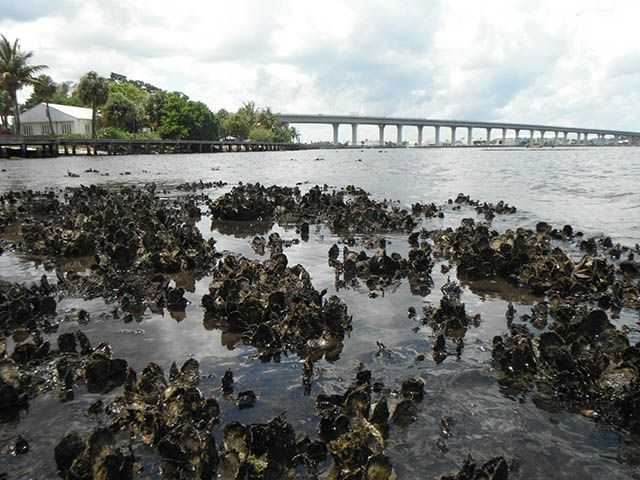
[dropcap]T[/dropcap]he Treasure Coast certainly has its fair share of popular raw bars, serving up plates of oysters on the half shell – but since our waters don’t support a commercial oyster fishery, what’s the point of devoting money and manpower to extensive oyster reef restoration? What good are our oysters if we can’t eat them? Simply put, oysters are hardly a one-trick pony. Here’s a quick rundown of the benefits of our local oysters, even though we can’t slurp them down with Tabasco and a cold beer.
Habitat
Oyster reefs provide a home for things we like to eat, things we enjoy fishing for, and things that provide a meal for many other species. Up to 75% of commercial and 80-90% of recreational fish species rely on estuaries at some point during their life. Oyster reefs (along with seagrass beds and mangroves) represent one of the most important estuarine habitats in the Indian River Lagoon and its tributaries. In our local estuaries, oyster reefs – with their countless recesses and hiding places – provide nursery habitat for juvenile snapper, grouper, stone crabs, blue crabs, shrimp, and many other species that we enjoy as dinner guests. Additionally, oyster reef habitats are home to countless small shrimp, crab, and baitfish species that represent prey for larger gamefish. Adult snook, redfish, trout, jacks, and bull sharks are a common sight around natural and restored oyster reefs in the Indian River Lagoon, Loxahatchee, and St. Lucie estuaries.
Filtration
Think of oysters as tiny aquarium filters. As long as an oyster is submerged, it is almost constantly pumping water through its shell and across a filter-like structure. Oysters eat the tiny particles that get stuck to this filter – particularly single-celled algae that float in the water column. If you’ve ever seen our water turn pea green or brown during an algae bloom, you know what oysters like to eat (this is the main reason we don’t eat South Florida oysters – when you eat a raw oyster, you are also eating its last meal, and our waters are home to some oyster food that will make you pretty sick). An adult oyster can filter up to 50 gallons of estuarine water every day. Try to wrap your head around the incredible amount of water a healthy reef with 100 million oysters could filter.
Shoreline stabilization
While it’s fun to pitch a live mullet up against a seawall in the fall, these featureless artificial structures really don’t provide much in the way of quality habitat for fish and crustaceans. However, when oyster reefs grow in close proximity to shore, they provide a natural breakwater that dissipates wave energy and reduces erosion just like a seawall. The “living shoreline” approach to coastal restoration combines a nearshore oyster restoration reef with seagrass and marsh grass plantings to create an erosion-resistant and habitat-rich shoreline. Waterfront homeowners throughout the area have embraced the living shoreline concept, and are generally very happy with the results. The fish, crabs, and shrimp appreciate the gesture too.
It should be clear that oysters are valuable both on and off the plate, but how exactly does oyster reef restoration work? When it’s time to settle down and attach to something solid, tiny larval oysters gravitate towards other oyster shells (more specifically, they’re attracted to the calcium carbonate in oyster shells – the same material that makes up limestone and chalk). By putting out mesh bags filled with oyster shell from local restaurants and raw bars, Florida Oceanographic Society’s oyster restoration program provides an ideal place for tiny oysters to colonize and grow. To date, this program has created more than 10,000 square feet of healthy restored reef in the St. Lucie estuary, while at the same time, keeping tons of shell out of the landfill. Since the supply of restaurant shell is limited, larger restoration projects frequently use fossilized shell or chunks of limestone rock to provide a place for tiny oysters to attach.
Oyster reef restoration creates habitats that very quickly begin to function just like natural oyster reefs. In 2010, Martin County created 5.8 acres of oyster restoration reef in the Loxahatchee River. Less than two years later, the artificial oyster reef closely resembled a natural oyster reef both from the perspective of oyster growth, as well as the number and type of small animals living in the recess of the reef. At that time, the relatively small restoration reef was home to more than 3500 pounds of tiny crabs, shrimp, and baitfish – essential prey for other estuarine species. Live oysters had grown across the restored reef site, and were filtering more than 18 million gallons of water every day – that’s almost 30 Olympic-sized swimming pools per day! Over time, as live oysters continue to spread and grow on the restoration reef, it will become difficult to tell that human’s ever played a role in its creation.
For more information on Florida Oceanographic’s oyster restoration program, including potential volunteer opportunities to help with shell bagging and reef deployment, visit www.floridaocean.org.
Zack Jud, Ph.D., is the Director of Education at Florida Oceanographic Society. He is a coastal ecologist (researching tarpon, snook, bonefish, permit, and lionfish), a marine science educator, and a fly casting and fly tying instructor. Zack can be reached at zjud@floridaocean.org.
